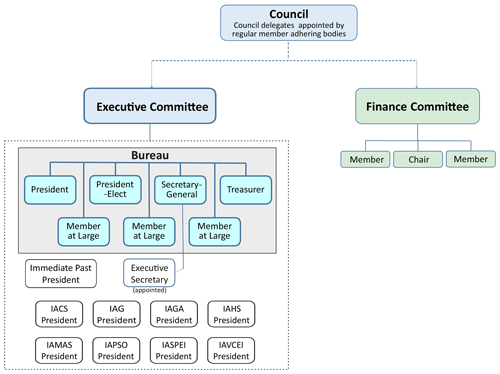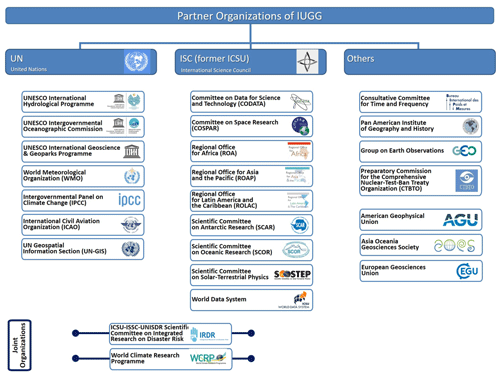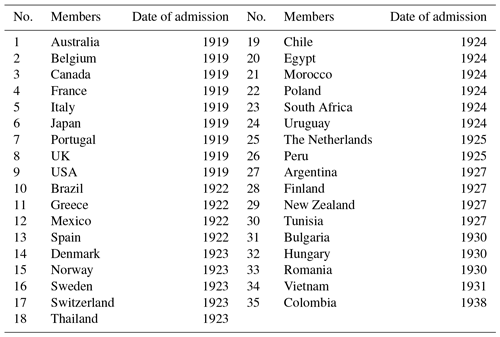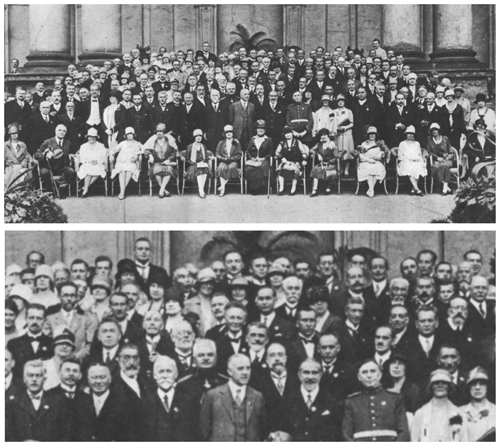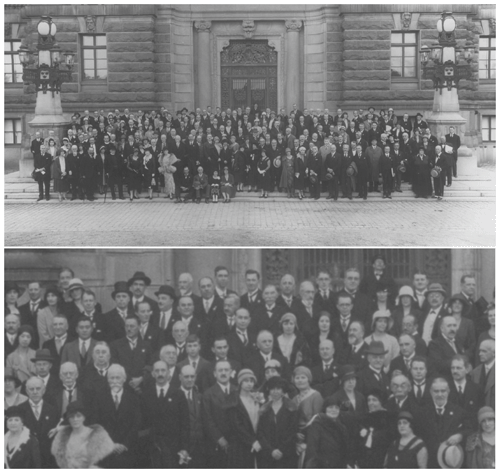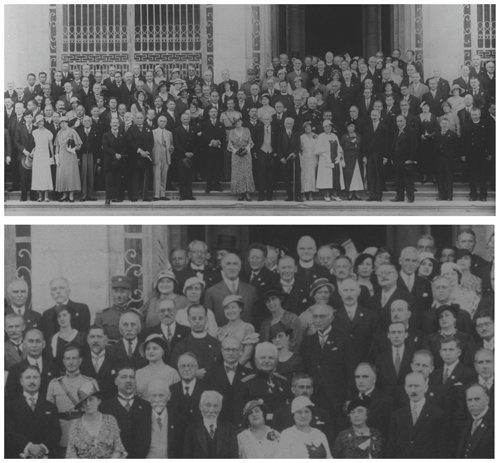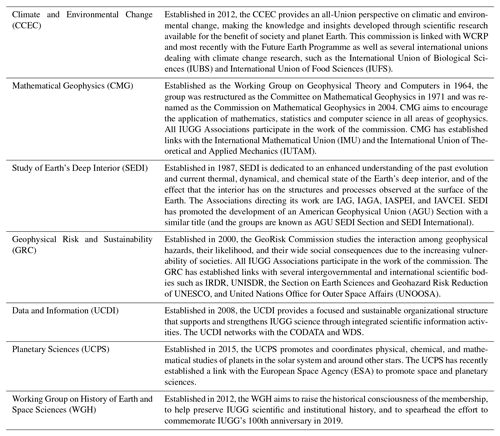the Creative Commons Attribution 4.0 License.
the Creative Commons Attribution 4.0 License.
IUGG: beginning, establishment, and early development (1919–1939)
Alik Ismail-Zadeh
Jo Ann Joselyn
The International Union of Geodesy and Geophysics (IUGG) was established in 1919 to promote activities of already-existing international scientific societies dealing with geodesy, terrestrial magnetism and electricity, meteorology, physical oceanography, seismology, and volcanology. At the first General Assembly a Section of scientific hydrology was added, making a total of seven Sections of the Union. This paper introduces IUGG by presenting its current mission, structure, partners, and programs; discussing various international geophysical efforts before its origin; and describing the Union's development from the end of World War I to the beginning of World War II. During this period (1919–1939), the number of member countries increased from the 9 founding Member countries to 35; seven General Assemblies were held, each in a different international venue; and the number of delegates attending the assemblies increased from a few dozen to more than 800 scientists. At the Fifth General Assembly in 1933, the term “section” was replaced by “international association”. Each General Assembly of the Union, since the First General Assembly in Rome, Italy, in 1922 to the VII General Assembly in Washington, DC, USA, in 1939, is summarized, and the distinguished scientists who contributed to the Union's formation and it early development are introduced.
The International Union of Geodesy and Geophysics (IUGG; http://www.iugg.org, last access: 20 February 2019) celebrates its 100th anniversary in 2019. Under its umbrella, eight international scientific associations and several interdisciplinary bodies comprising about 100 divisions, commissions, committees, working groups, and geodetic and geophysical services cover almost all disciplines of geo- and space sciences and promote research of the Earth from its core to its space environment up to the Sun. It is dedicated to advancing basic (fundamental) science and to solving challenging societal problems such as climatic and environmental changes, disaster risk reduction, water security and quality, and energy.
Written for the occasion of IUGG's centennial, this and two subsequent articles in this special issue document the history, current activities, and possible future development of IUGG. To appreciate the history of IUGG, we start the paper with a description of the Union and its current structure, partnerships, and operating principles. Then we look back to examine the founding and early history of the Union from the end of the First World War (WWI) and the beginning of the Second World War (WWII), including descriptions of early General Assemblies and distinguished leaders. Two other papers cover (i) the Union's history after WWII until the end of the last century and (ii) its development in the 21st century. These papers do not pretend to offer a comprehensive and definitive account of all activities of the Union for the last 100 years, but rather highlight major activities of and administrative and structural changes in IUGG during that time.
IUGG is a dynamic non-governmental, not-for-profit, scientific organization that brings together scientists and science organizations from many countries in which geophysical sciences and geodesy have a role. IUGG encompasses multiple scientific disciplines through its associations and commissions, and hundreds of thousands of individuals from all over the world through its Adhering Organizations (e.g., national academies, research councils, governmental agencies). IUGG has a long and storied history; about 100 countries have been IUGG members for a full century, and since its founding in 1919, the Union has had two official languages: English and French. The official title of the Union in French is l'Union Géodésique et Géophysique Internationale (UGGI).
IUGG is governed by a Council of its Adhering Bodies, and cooperates with an impressive list of international and intergovernmental organizations. Any country that has developed independent activity in geodesy and geophysics may adhere to the Union. National Members (the Adhering Body) set up IUGG National Committees that organize IUGG-related activities in their countries. Many scientists participate in Union activities through these National Committees and represent their countries at IUGG general assemblies.
Presently, there are four categories of membership: Regular (the Adhering body has paid annual dues set by the Finance Committee); Observer (payment of dues has temporarily lapsed); Associate (the Adhering Body otherwise meets the criteria for regular membership but does not pay dues); and Affiliate (organizations awarded the same rights, duties and obligations as Associate Members). Membership waxes and wanes for reasons including changes in financial circumstances, politics, and scientific activity. For instance, financial problems experienced by a scientific institution adhering to the union may lead to the loss of membership for the country involved. Many political borders have changed since 1919, which at times affects member countries. Less-affluent countries may lack a critical mass of scientists to share the mission and major purposes of international unions, or severe political, economic, and financial problems may prevent regular membership (Ismail-Zadeh, 2016a). Scientists in these countries are encouraged to participate in IUGG's scientific activities for the benefit of science in their countries and for their contribution to geographic coverage that is crucial for global geoscience.
Between face-to-face meetings of the Council that take place at quadrennial General Assemblies of the Union, the affairs of the Union are vested in the Bureau and the Executive Committee (Fig. 1). The Bureau consists of the President, President-Elect, Secretary General, Treasurer, and three additional Members, elected by the Council. The Executive Committee consists of the Bureau, the Presidents of the International Associations, and the immediate Past President of the Union. The Executive Committee coordinates the scientific work of the Associations and formulates the general policies that guide the scientific objectives of the Union. At each General Assembly, a Finance Committee of three members is elected also by the Council. Besides advising the Council, Bureau, and the Executive Committee on financial matters, the Finance Committee receives and reviews audits of the accounts, advises the Treasurer on preparing the budget and on raising funds to support Union and Association activities, and reviews the category of membership of National Members. Also at each General Assembly, the Council adopts resolutions, i.e., statements affirming a scientific finding or plan of action. These findings are generally recommended to the Council Members by the Associations, which must first adopt the matter at their Association Scientific Assemblies. These resolutions are powerful endorsements of scientific viewpoints that have been used to establish standard nomenclature and methods of measurement, support international scientific campaigns, align global scientific opinion, and obtain funding from governmental and non-governmental agencies. From time to time, between General Assemblies, the IUGG Bureau may issue statements expressing a unanimous opinion on a topic of scientific significance. The most recent statement, issued on 12 June 2017, was entitled “The Earth's climate and responsibilities of scientists and their governments to promote sustainable development”.
2.1 Union structure
IUGG is dedicated to advancing, promoting, and communicating knowledge of the Earth system, its space environment, and the dynamical processes causing change. IUGG is a confederation of eight semi-autonomous international scientific associations, each having its own executives, and is responsible for a specific domain of topics or themes within the overall scope of Union activities. These associations are the following.
-
International Association of Cryospheric Sciences (IACS)
-
International Association of Geodesy (IAG)
-
International Association of Geomagnetism and Aeronomy (IAGA)
-
International Association of Hydrological Sciences (IAHS)
-
International Association of Meteorology and Atmospheric Sciences (IAMAS)
-
International Association for the Physical Sciences of the Oceans (IAPSO)
-
International Association of Seismology and Physics of the Earth's Interior (IASPEI)
-
International Association of Volcanology and Chemistry of the Earth's Interior (IAVCEI)
Within the framework of the Union's Statutes and By-laws, its International Associations adopt their own Statutes and By-laws and control their administration and finance. The beginning, establishment, and historical development of the Union Associations are subjects of related papers in this special issue.
The majority of the Union's scientific work takes place within the Associations and their inter-Association bodies. At present, IUGG and its Associations operate through more than one hundred scientific divisions, commissions, committees, working groups (WGs), and services (see Fig. 1 in Ismail-Zadeh, 2016a). The Union enables interdisciplinary science on topics of common interest through three types of IUGG interdisciplinary bodies: Union commissions, Inter-Association commissions, and Union committees. Union commissions are co-sponsored by at least four associations (listed below) and often share activities with other notable international scientific organizations. IUGG Inter-Association commissions are co-sponsored by two or three associations, the most prominent being the IUGG Tsunami Commission and the IUGG Working Group on Electromagnetic Studies of Earthquakes and Volcanoes (EMSEV). Union and Inter-Association Commissions deal with science, whereas Union committees deal with administration (the names were clarified in 2004). In addition, several ad hoc committees are set up before IUGG General Assemblies to deal with topics such as nominations, site evaluations, and resolutions. At present, the following Union Commissions, Working Group, and Standing Committees are active: Union Commissions on Climatic and Environmental Changes (CCEC), Mathematical Geophysics (CMG), Geophysical Risk and Sustainability (GRC), Study of the Earth's Deep Interior (SEDI), Data and Information (UCDI), and Planetary Sciences (UCPS); the Working Group on History of Earth and Space Sciences; and Standing Committees on Capacity Building and Education, Honors and Recognition, Outreach, Statutes and By-Laws, and Visioning. Brief summaries of the current Union commissions and committees can be found in Appendix A.
2.2 Union programs and products
IUGG has initiated and/or vigorously supported collaborative efforts that have led to highly productive international multi- and interdisciplinary programs. Current IUGG programs include the International Lithosphere Program (ILP), Global Geodetic Observing System (GGOS), Geoscience Education, Publication, Grants, and Honor and Recognition programs. Description of the programs can be found in Appendix B.
IUGG Associations work to set global standards for research and agree on definitions, equations, and algorithms. The Union's products include the International Classification for Seasonal Snow on the Ground, the International Terrestrial Reference Frame, the International Geomagnetic Reference Field, the International Thermodynamic Equation of Seawater, the Manual of Seismological Observatory Practice, and the Guidelines for Professional Interaction During Volcanic Crises. Detailed description of the products is presented by Ismail-Zadeh (2016a). The internationally driven services and products of IUGG Associations are absolutely unique; they could not be done by any governmental organization even though operations of the services depend on national funding.
2.3 The International Science Council and IUGG
In 1899, representatives of European and US academies met in Wiesbaden, Germany, and established the International Association of Academies, which was active until WWI (Greenaway, 1996). Already during WWI, scientific leaders from the allied nations thought about the post-war renewal of international scientific cooperation because of political and scientific reasons (Good, 2000). Representatives of national academies of allied countries met in London, Great Britain, in October 1918 and then in Paris, France, in November 1918, and decided to establish an International Research Council (IRC; Wood, 1919). The IRC was established in Brussels, Belgium, in July 1919, together with several scientific unions including IUGG. The main aims of the Council were “(i) to coordinate international efforts in the different branches of science and its applications; (ii) to initiate the formation of international associations or unions deemed to be useful to the progress of science; (iii) to direct international scientific action in subjects which do not fall within the province of any existing association; and (iv) to enter, through the proper channels, into relations with the Governments of the countries adhering to the Council to recommend the study or questions falling within the competence of the Council” (Lyons, 1919). At the beginning, IRC was a non-inclusive council by its laws excluding the Central Powers from membership in the Council and its scientific unions, and admitting neutral countries only by a three-quarters majority vote. However, that, immediately after the end of WWI, about two hundred members of the academies of neutral nations called on the members of the academies of allied nations “for cooperation in order to prevent science from becoming divided, for the first time and for an indefinite period, into hostile political camps” (Scientific Events, 1919). The Council was a part of the general post-WWI policy of isolating the Central Powers (Cock, 1983). Only in 1926, IRC agreed to delete from its Statutes the clause related to exclusion of the Central Powers from membership, and invited Austria, Bulgaria, Germany, and Hungary to adhere to IRC. Unfortunately, none of these countries could join IRC at that time for a variety of reasons (IRC, 1928; Greenaway, 1996).
The IRC was active until 1931, when the International Council of Scientific Unions (ICSU) was established to promote international scientific activity in different branches of science and interdisciplinary research between the unions. IUGG was one of the active supporters behind establishing ICSU and became a founding member of the Council. ICSU formally changed its name to the International Council for Science at an Extraordinary Assembly in 1998, keeping its acronym and logo to maintain historical continuity. ICSU provided a global forum for scientists in all scientific disciplines to exchange ideas and information and to develop standard methods and procedures for all fields of research. IUGG brought expertise on Earth and environmental studies from researchers in its International Associations and Union commissions. IUGG strongly supported ICSU's policy of non-discrimination, which affirms the rights and freedom of scientists throughout the world to engage in international scientific activity without limitation by such factors as citizenship, religion, creed, political stance, ethnic origin, race, color, language, age or gender.
At the ICSU extraordinary General Assembly and the General Assembly of the International Social Science Council (ISSC) held in Oslo, Norway, in October 2016, ICSU and ISSC members agreed to merge the two councils. In October 2017, a new organization, International Science Council (ISC), was founded at the joint ICSU and ISSC General Assembly in Taipei to advance science as a global public good and to act as a global voice of science, and was formally established on 30 June 2018. Although initially IUGG and some other ICSU and ISSC Members questioned the necessity and urgency of the merger (24 % of the ICSU Members and 13 % of the ISSC Members voted against it), IUGG was convinced later that the merger would benefit scientific development and play significant role in bridging science to society and policymaking. IUGG became a founding member of the new Council. The inaugural General Assembly of ISC was held on 3–5 July 2018 in Paris, France, where the first Governing Board of the new Council was elected. IUGG Secretary General Alik Ismail-Zadeh was elected the first Secretary of Council.
IUGG had participated in ICSU's leadership since its inception in 1931. The first Secretary General of the Council was Sir Henry George Lyons, IUGG Secretary General (1919–1930) and the IRC Secretary General (1928–1931) (Cheetham, 1947). In recent years, Vladimir Keilis-Borok (IUGG President, 1987–1991), Uri Shamir (IUGG President, 2003–2007), and Guoxiong Wu (IUGG Executive Committee Member and IAMAS President, 2007–2011) have served on the ICSU Executive Board. Tom Beer (IUGG President, 2007–2011) and Harsh Gupta (IUGG President, 2011–2015) have served on the ICSU Committee on Science Planning and Review. Gordon McBean (Member of the IUGG Bureau, 1987–1995) served as the last ICSU President from 2014 until 2018, when the new council was formed.
IUGG cooperates with ISC International Scientific Unions, especially those dealing with Earth and space sciences, to promote the interdisciplinary sciences worldwide (see about GeoUnions in Joselyn et al., 2019). There are a number of ISC scientific committees for which IUGG appoints liaisons to foster cooperation between the interdisciplinary committees and IUGG. These include the Committee on Data for Science and Technology (CODATA); the Committee on Space Research (COSPAR); the Scientific Committee on Antarctic Research (SCAR); the Scientific Committee on Oceanic Research (SCOR); the Scientific Committee on Solar-Terrestrial Physics (SCOSTEP); the World Data System (WDS); and the ISC Regional Offices for Africa, Asia and the Pacific, and Latin America and the Caribbean. IUGG is particularly active with the Scientific Programme of Integrated Research on Disaster Risk (IRDR) co-sponsored by ISC and the United Nations Office for Disaster Risk Reduction (UNISDR), and the World Climate Research Programme (WCRP) co-sponsored by ICSU, the World Meteorological Organization (WMO) and the Intergovernmental Oceanographic Commission (IOC) of the UN Educational, Scientific and Cultural Organization (UNESCO).
ICSU provided grants to promote major scientific campaigns proposed by the participating Unions, and IUGG proposals have often been successful. For example, in 2010, IUGG received an ICSU grant for a project proposal, “Extreme Natural Hazards and Societal Implications – ENHANS”; in 2011, for a project proposal, “eGYAfrica – better Internet connectivity for research and education institutions in Africa”; and in 2014, for a project proposal, “Uniting and networking the magnetic community in the northern Indian Ocean region”.
2.4 Partners
IUGG envisions a future Earth that is environmentally sustainable and where societies are resilient against natural hazards. To achieve this goal, participation in global networks of interdisciplinary programs is vital. IUGG places particular emphasis on the scientific problems of economically less-developed countries by sponsoring activities relevant to their scientific needs. In addition to the many beneficial relationships that IUGG Associations develop with partners, IUGG as a whole also develops and maintains formal contacts with a wide range of organizations, detailed here (see Fig. 2 for the partners of the Union).
The formation of the United Nations (UN) in 1945 and its specialized agencies broadened the scope of international involvement of IUGG in scientific programs (Ismail-Zadeh, 2016a). Through its Associations, IUGG has established productive relationships with WMO; UNESCO; the UN Cartographic Section (now the UN Geospatial Information Section); the International Civil Aviation Organization (ICAO); the UN Committee of Experts on Global Geospatial Information Management (UN-GGIM); and the UN Environmental Program (UNEP). Cooperation with WMO includes meteorology (via IAMAS), hydrology (IAHS), cryosphere (IACS), space weather (IAGA), and volcanology (IAVCEI), and extends to its specialized bodies such as the Global Framework for Climate Sciences (GFCS). Particularly, after the 2010 Eyjafjallajökull volcano eruption and at ICAO's request, WMO and IUGG established a joint Volcanic Ash Scientific Advisory Group (VASAG) to provide scientific advice on volcanic ash to civil aviation. Representatives of IUGG have been invited to WMO Executive Congresses and representatives of WMO have been invited to IUGG General Assemblies.
IUGG had established in 1946 (Stagg, 1947) and maintains a working relationship with UNESCO and its scientific bodies, including IOC and International Hydrological Programme (IHP) through IAPSO and IAHS since those bodies'establishment in 1960 and in 1975, respectively. For example, IAHS established the International Hydrology Prize in 1981 in cooperation with IHP and WMO to award distinguished scientists who have made an outstanding contribution to hydrological science. For years, IUGG via IASPEI and IAVCEI cooperated with the UNESCO section on Earth Science and Geohazard Risk Reduction in the framework of its programs related to earthquake and volcano hazards and risks, and since 2017, in the framework of the International Geoscience and Geoparks Programme. IUGG also cooperates with the Comprehensive Nuclear-Test-Ban Treaty Organization (CTBTO) Preparatory Commission in studies related to seismology, hydroacoustics, and atmospheric transport modeling and assists scientifically in organizing the CTBT Science & Technology conferences. Compared to intergovernmental organizations, which are constrained by their governmental framework, IUGG and other non-governmental, international scientific unions, provide independent advice on scientific subjects within their expertise.
The UN General Assembly adopted the 2030 Agenda for Sustainable Development in 2015 (https://sustainabledevelopment.un.org/sdgs, last access: 20 February 2019). The Agenda seeks to link issues such as climate change, natural disasters and education. It intertwines social, economic, and environmental targets in 17 Sustainable Development Goals (SDG). Each of the SDGs is divided into several sub-goals. All IUGG Associations, the Union Commissions on Geophysical Risk and Sustainability, Climatic and Environmental Change, and Data and Information as well as the IUGG Committee on Capacity Building and Education seek to contribute to the sub-goals related to climatic change, natural hazards and risk, gender issues, education and capacity building, research and innovation (Ismail-Zadeh, 2016b).
The Group on Earth Observations (GEO) is a voluntary partnership of governments and international organizations that provides a framework for developing projects and coordinating strategies and investments among partners. GEO coordinates efforts to build a Global Earth Observation System of Systems (GEOSS). At the GEO-X Plenary in 2014, IUGG was unanimously recognized as a Participating Organization of GEO, although several of IUGG's bodies, including IAG, had earlier been Participating Organizations.
Through IAG, IUGG also names liaisons to and partners with the Consultative Committee for Time and Frequency (CCTF) and the Pan American Institute of Geography and History (PAIGH). The CCTF is a body of the Bureau International des Poids et Mesures (BIPM), the inter-governmental organization through which member states act together on matters related to measurement science and standards such as the leap second. PAIGH is a technical and scientific body of the Organization of American States.
It is difficult to trace back to the earliest date when international cooperation in geodesy and geophysics began, but it is evident that such cooperation became important in the early 19th century. For example, in the first decades of the 19th century, Edward Sabine, an Irish astronomer and geophysicist, and Alexander von Humboldt, a German geographer and naturalist, together with a few other scientists, organized widespread magnetic observations (Good, 2000; Collier, 2014). This motivated Carl Friedrich Gauss, a German mathematician, together with von Humboldt and Wilhelm E. Weber, a German physicist, to found in 1836 the Göttingen Magnetic Union, the first worldwide network of magnetic observatories. This international organization promoted a cooperative scheme of simultaneous observations in which more than 50 observatories distributed over five continents took part (Chapman, 1955; Linthe, 2007). In the 1860s, Johann Jacob Baeyer, a Prussian general and geodesist, was proactive in building scientific cooperation in Europe on measurements of the size and shape of the Earth. He was a driving force in the formation of the Mitteleuropäische Gradmessung (Central European Geodetic Association) in 1862, which became the Association Géodésique Internationale (the International Association of Geodesy, IAG) in 1886 (Angus-Leppan, 1984). Conferences and international contacts were sporadic prior to the second part of the 19th century. Prince Albert I of Monaco, who devoted time and resources to oceanography, granted his patronage to the establishment of the International Marine Association in 1900 (Smythe-Wright et al., 2019). John Milne, a British geologist and mining engineer who was invited by the Japanese government to Tokyo in 1875, established the Seismological Society of Japan together with British and Japanese physicists and seismologists. The First International Conference on Seismology was held in Strasbourg (then a German city) in 1901, and the International Seismological Association was founded in 1904 (Pomerantzef, 1904; Schweitzer, 2003).

Figure 3The inaugural IRC General Assembly and establishment of IUGG. (a) Palais des Academies at Brussels, Belgium, where the IRC assembly was held in July 1919; (b) IUGG officers: (from left to right) Louis A. Bauer, V. Reina, Aikitsu Tanakadate, Hermant, and Charles Chree participating in the Assembly (Bauer, 1919).
By the outbreak of WWI in 1914, international organizations for geodesy, seismology, meteorology, geomagnetism, geoelectricity, and oceanography had already been established. The war interrupted the operation of these bodies, although some were kept active by then-neutral nations. During WWI, some scientific leaders from the allied nations gave thought to the post-war renewal of international scientific cooperation. Though early efforts in international cooperation within international associations and the network of national academies were very successful, discussion between existing geoscientific societies and national academies was limited, forcing scientists to devise a new model of cooperation (Good, 2000; Ismail-Zadeh, 2016a). In 1918, representatives of the scientific academies of allied nations decided to foster international scientific cooperation, and establish together with the IRC scientific unions to organize and promote international cooperation. In particular, a resolution was passed in favor of establishing an international geophysical union “for the purpose of initiating and promoting researches in geophysics” (Wood, 1919), to be made up of all existing scientific groupings dealing with the physical sciences of the Earth. The original proposal for the name of the union was the “international geophysical union” (Ismail-Zadeh, 2016a). However, in May 1919, at a preliminary meeting, the IRC adopted an expanded name, “International Union of Geodesy and Geophysics” (IUGG), based on a motion of the representative from Italy (Bauer, 1919). The motivation of the Italian representative is unknown; one conjecture is that in the beginning of the 20th century geodesy positioned itself as a branch of mathematics rather than a branch of physical sciences, and this may be the reason why geodesy was listed separately from all other physical disciplines of IUGG at the time of the Union's establishment (Ismail-Zadeh, 2016a). At the same meeting, draft Statutes for IUGG were adopted. The International Astronomical Union (IAU) was formed at the same time; one reason for the early establishment of these two unions was that in both cases “their basic studies had always required international action so international `union' came naturally” (Greenaway, 1996).
The formation of IUGG was finalized at the first IRC General Assembly held on 18–28 July 1919 (Fig. 3), with the approval of its Statutes and future activities (Lyons, 1919). The first nine Member countries of IUGG were Australia, Belgium, Canada, France, Italy, Japan, Portugal, the United Kingdom, and the United States of America. IUGG included several branches of science for which special organizations had existed for many years, well before WWI. They were reconstituted as six Sections within IUGG, each with its own executive committee. According to Bauer (1919), those initial Sections were (1) Geodesy (President William Bowie, USA, and Secretary Georges Perrier, France); (2) Terrestrial Magnetism and Electricity (President Aikitsu Tanakadate, Japan, and Secretary Louis Agricola Bauer, USA); (3) Meteorology (President Sir William Napier Shaw, UK, and Secretary Charles Frederick Marvin, USA); (4) Physical Oceanography (naming of a President was deferred, and Secretary Giovanni P. Magrini, Italy; later Prince Albert I of Monaco was elected President of this Section); (5) Seismology (the organization of the Section was deferred because of the agreement among the founding member countries regarding the continuation of the International Seismological Association); and (6) Volcanology (President Annibale Riccò, Italy, and Secretary Alessandro Malladra, Italy). Charles Lallemand (France) became the first President of the Union, serving until 1933, and Sir Henry G. Lyons was the first IUGG Secretary General, serving until 1930. Four Vice-Presidents were named: H. S. H. Prince Albert I of Monaco, Bowie (USA), Sir Shaw (UK), and Tanakadate (Japan).
Although German scientists and academies played an important role in the establishment of international associations in geodesy and seismology, the involvement of Germany and other countries of the Central Powers as well as Russia in geodetic and geophysical cooperation was interrupted by WWI and the Russian Revolution in 1917. Following the IRC rules, the IUGG membership at the beginning was restricted to the allied and neutral nations. Although the ISC restriction on the membership was removed in 1926, and IUGG's own membership became more inclusive, the international cooperation between allied, Central Power, and neutral countries resumed to the full extent only after WWII (Cock, 1983; Good, 2000; Ismail-Zadeh, 2016a).
The Union was established for the period of 12 years, subject to renewal and modification at the end of this period. Delegates of IUGG Member countries agreed to hold general assemblies of the Union every 3 years. Also, they decided that the Union could meet at any place and not necessarily at the same place as the IRC, and Union Sections could call special meetings when they found them necessary. The objectives of the Union as stated in the Statutes were (1) to promote the study of problems concerned with the figure and physics of the Earth; (2) to initiate and coordinate researches which depend upon international cooperation and to provide for their scientific discussion and publication; and (3) to facilitate special researches such as the comparison of instruments used in different countries (Bauer, 1919).
IUGG has held general assemblies (GAs) since 1922 (quadrennially since 1963). Its first assemblies gathered only a few hundred scientists, and the GA in Washington, DC, USA, in 1939 was attended by more than 800 people, although only a little more than 200 foreign scientists could participate due to the war. Table 1 presents some statistics related to the Union's first seven GAs, and Table 2 lists Member countries connected with the Union from 1919 to 1939.
4.1 First General Assembly (3–10 May 1922, Rome, Italy)
The First General Assembly (GA) brought together delegates from the founding Member countries and from four new Member countries (Brazil, Greece, Mexico, and Spain), and a number of representatives from other countries that had not yet joined the Union. The sessions were held in the Reale Accademia dei Lincei. The delegates were welcomed by the Minister of Public Instruction at the Capitol in the presence of His Majesty the King of Italy (Lyons, 1922). All Sections had made good progress in planning international cooperation in the years since 1919, and work plans were adopted for the next 3 years. In 1919 at the GA in Brussels, it was suggested that the study of variation of latitude should be confided to the IAU. At the GA in Rome this question was discussed in detail with the IAU representatives; it was decided that the subject should remain with the Section of Geodesy, and a joint committee of geodesists and astronomers was appointed to direct the work. As the International Association of Seismology still existed at the time of the GA in Brussels, the IUGG Section of Seismology was only formally constituted at Rome. Seismologists discussed topics related to microseisms, earthquake focal depths, and wave propagations (Lyons, 1922). One of the important discussions among meteorologists at the GA was related to the cooperation with the International Meteorological Organization (IMO, the predecessor of the WMO), which brought together meteorological services of several countries. It was agreed that the investigations, which required international cooperation, could be difficult for the national services to include in their activities, and hence the Section of Meteorology could initiate and promote such investigations. The Section of Terrestrial Magnetism and Electricity discussed the methods of observation required for different types of instruments, and the possibilities for international comparison of instruments. The Section of Physical Oceanography discussed how to facilitate international cooperation in physical oceanography, and how the collection of tidal information could be improved. The Section of Volcanology discussed the classification of volcanic phenomena, and studies of the thermal gradients in several regions. At that GA, a Section of Scientific Hydrology was added, making a total of seven Sections. Also at that GA, it was decided that instead of electing Vice-Presidents, the Presidents of the IUGG Sections would serve in that capacity. Charles Lallemand (France) was elected IUGG President, and Sir Henry G. Lyons (UK) Secretary General.
4.2 Second General Assembly (1–8 October 1924, Madrid, Spain)
The Second General Assembly of IUGG was held in Madrid at the invitation of the Spanish Government. Ten new Member countries adhered to the Union by 1924 (Table 2). The scientific work of the GA was carried on in the seven Union Sections. In the Section of Geodesy, an International Ellipsoid of Reference (a surface that approximates the geoid, that is, the Earth's figure) was discussed and adopted. In the Section of Seismology, it was decided to continue the publication of the International Seismological Summary at Oxford. A joint meeting of the Sections of Meteorology and Physical Oceanography on marine meteorology, and a joint meeting of the Sections of Meteorology and Scientific Hydrology on the measurement of rainfall data were organized. The Section of Terrestrial Magnetism and Electricity decided to promote studies on the international comparison of instruments, and on the magnetic and electrical characterization of days. Much attention was given to echo-sounding and to tidal phenomena by the Section of Physical Oceanography, which also discussed jointly with the Section of Geodesy the subject of earth tides. Changes in the geothermal gradient in the vicinity of volcanoes were discussed at a joint meeting of the Sections of Volcanology and Seismology. Valuable reports on the 1923 Great Kanto earthquake in Japan and on the gauging of the Nile discharge were presented at the GA. The extension of the work by the Section of Scientific Hydrology to the phenomena of glaciers was also considered. The Spanish Government hosted the GA in the Chamber of Deputies, and His Majesty the King of Spain presided at the Opening Ceremony of the GA; a reception was held at the Palace by their Majesties the King and the Queen, to which all the delegates were invited (Lyons, 1924).
4.3 Third General Assembly (3–10 September 1927, Prague, Czechoslovakia)
The Third General Assembly was held in Prague at the invitation of the Czechoslovakian Government (Fig. 4). Six new Member countries adhered to IUGG by 1927 (Table 2). The GA urged the countries concerned to improve the network of existing seismic stations by establishing new stations. A proposal of the US National Committee on international cooperation in the studies of ocean deeps was strongly supported. The Section of Meteorology worked closely with IMO, complementing the work of the other (Davies, 1990); IMO occupied with matters related to the working of the meteorological services in various countries and the Section dealt with many scientific matters related to meteorology and atmospheric physics. The Section of Terrestrial Magnetism and Electricity considered among other topics the works on atmospheric ionization and the observations of auroras, and expressed the need for additional earth current installations. The Section of Physical Oceanography considered the investigations of the different great sea areas and of tidal phenomena. The Section of Volcanology adopted a resolution that countries in which active volcanoes occur should be invited to undertake the measurement of the thermal gradient. The Section of Scientific Hydrology discussed the problems related to the flow of water and the transport of silt in suspension. Also, by agreement with the International Committee on Glaciers (established in 1894), its work was transferred to the Section to be carried out by a committee set up for this aim. Generous hospitality was shown to the GA's delegates by the Czechoslovakian Government and by the municipality of the city of Prague. The President of the Republic was to have received the delegates on one evening, but unfortunately, his health did not allow him to return to Prague, and the Minister of Foreign Affairs hosted the reception on his behalf (Lyons, 1927).
4.4 Fourth General Assembly (15–23 August 1930, Stockholm, Sweden)
The Opening Ceremony of the Fourth General Assembly was held in the Concert Hall, where the Chancellor of the Universities and Chairman of the Swedish National Committee welcomed the delegates, and IUGG President Charles Lallemand replied and expressed thanks for hospitality and excellent arrangement of the meeting. Bulgaria, Hungary, and Romania joined IUGG in 1930. The scientific and business meetings of the GA were held in the Parliament House (Fig. 5). Scientific topics were discussed by the Union Sections. Felix A. Vening-Meinesz presented work on the determinations of gravity at sea, and the GA expressed the hope that other nations with submarines could cooperate in the work of gravity determination over ocean areas (Lyons, 1930). Some time was dedicated by several Union Sections to discussing activities during the Second International Polar Year (IPY; 1932–1933); for example, it was decided to publish an auroral atlas as soon as the material could be selected and brought together (Lyons, 1930). Among business topics, the GA discussed changes in the Union's Statutes regarding the admission of new members. The changes were associated with much freedom, which IRC provided to its Union Members in arranging their own affairs based on a new type of relationship – a “cooperative independence” within the IRC family (Spencer-Jones, 1960). Also, the GA agreed to provide greater freedom for the Union's Sections to arrange their activities. The GA decided that future IUGG Presidents would hold office for one term and should not be immediately eligible for re-election, which would assist in maintaining the organization's international character. Swedish hospitality provided a number of occasions at which the delegates could discuss matters of common interest. The City Council gave a banquet in the City Hall, and H. R. H. the Crown Prince and the H. R. H. Crown Princess (Lyons, 1930) received the delegates at the Royal Palace. At that time, Harold St. John Lloyd Winterbotham (UK) became Secretary General of the Union, serving until 1946.
4.5 Fifth General Assembly (17–24 September 1933, Lisbon, Portugal)
At the Fifth General Assembly (Fig. 6), the term “section” was replaced by “international association”, and the associations become semi-autonomous, each responsible for specific scientific topics. Due to the great economic depression during the 1930s, the number of attendees decreased considerably compared to the GA in Stockholm in 1930; the membership dues for the coming 3 years were reduced by one-quarter, and provision was made for further reduction in exceptional cases even though this reduction could have resulted in shrinking scientific activities of the Union Associations. Despite the world economic perturbation and the onset of political and military disturbance, the Second IPY was conducted in 1932–1933. Magnetic, auroral, and meteorological data were collected from stations located in the Arctic and Antarctic, and were used to study the phenomena associated with terrestrial magnetism and weather forecasting. Some time was dedicated at the GA to discussing these data (IUGG, 1933; SIPY, 1933). This was the last GA to be held under the presidency of Charles Lallemand (France). William Bowie (USA) was elected President of the Union.
4.6 VI General Assembly (17–25 September 1936, Edinburgh, UK)
Delegates from IUGG Member countries and guests from several non-member countries, including Austria, Germany, India, and Russia, attended the Sixth General Assembly in Edinburgh (Fig. 7). At the opening ceremony, the President of the Royal Society, the Lord Provost of Edinburgh, the Principal of the University of Edinburgh, and the President of the Royal Society of Edinburgh welcomed the delegates. The scientific work of the Union that had been conducted by the several international associations was presented at various scientific sessions. Two evening Union Lectures delivered by A. L. Day (USA) on volcanoes and by Felix A. Vening-Meinesz (the Netherlands) on gravity measurements in submarines were the first public lectures given at a GA.
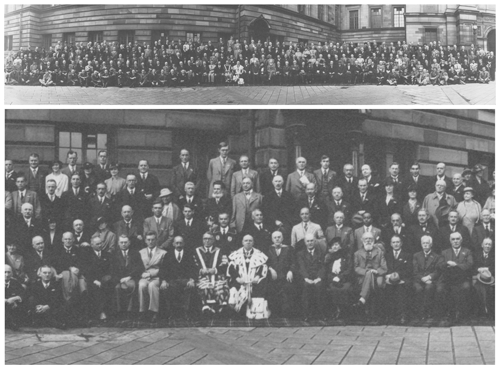
Figure 7Participants of the VI General Assembly (upper panel); details of the central part of the photo (lower panel) (source: IUGG archives).
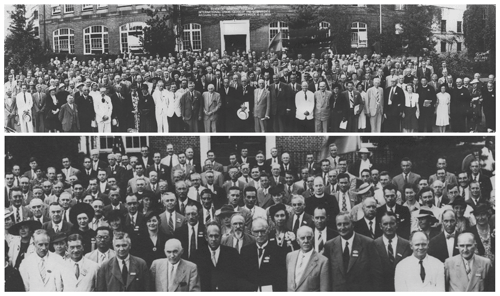
Figure 8Participants of the VII General Assembly (upper panel); details of the central part of the photo (lower panel) (source: IUGG archives).
Social hospitality was accorded to the Union by H. M. Government and the City of Edinburgh. Cooperation between the Union Associations was strengthened. Particularly, one step taken in this direction at the GA was to set up a special joint commission of the Associations to study the Earth's crust under the oceans. The International Association of Oceanography adopted the resolution urging a more effective collection of meteorological data over the oceans. Dan la Cour (Denmark) was elected IUGG President, serving the Union until his death in 1942. The dues for membership to the Union continued at the same level as for the period 1933–1936 (about 160 to 800 British pounds per annum according to the national population), and a substantial part of the Union's funds were divided among the seven Associations, as before (IUGG, 1936).
4.7 VII General Assembly (4–15 September 1939, Washington, DC, USA)
The Seventh General Assembly was overshadowed by the beginning of WWII. Out of 35 countries adhering to IUGG, representatives of just 20 were present; scientists of several non-member states participated in the scientific part of the GA. Meanwhile, a record number of delegates (805 including 225 non-US scientists) attended the General Assembly (Fig. 8). The US National Research Council hosted the Assembly, the first in North America, and AGU performed the duties of the organizing committee. The Honorable Cordell Hull, US Secretary of State, sent a welcoming address (IUGG, 1939; Fleming, 1940).
Preceding the Assembly, normal communication between Member countries had become impossible. By the end of August, President D. la Cour and Secretary General H. St. J. L. Winterbotham, after consulting the US Local Organizing Committee (President Richard Montgomery Field and Secretary John Adam Fleming), cabled to all Adhering Organizations that the GA would be held, but that the IUGG Executive Committee agreed that its activities would be confined to scientific matters only. It was expected that many delegates would be absent from the GA due to the war and, in fact, the whole French delegation and many of the British delegates, including Secretary General Winterbotham, were recalled back to their countries. A number of business items from the original agenda were excluded, such as discussion of administrative matters, proposed amendments of the Statutes, and the election of new officers and executive committees for the Union and its seven Associations. The existing officers continued their terms as an emergency measure. William Bowie, former President of the Union, was chosen as Acting Secretary General. The GA agreed to continue the financial management of the Union and scientific programs, so far as available funds allowed. Fortunately, IUGG (and some of the Associations) had accumulated reserves, and it was hoped that the work of the Union and its Associations could be continued until peace was restored (Fleming, 1940).
The absence of administrative business enabled the full time of the Assembly to be devoted to scientific discussion, including joint meetings among Union Associations. Scientific meetings of the GA were held in the buildings of George Washington University. There were two public lectures: “Geodesy and Mapping in the British Empire” by H. St. J. L. Winterbotham and “From the Mexican Gulf to the Arctic Sea: the Gulf Stream and its Significance” by Bjørn Helland-Hansen (Norway); 490 papers were presented during the GA (Fleming, 1940). It was agreed that the scientific discussions had been most useful and successful, and that the GA had been as valuable as it was harmonious. Nineteen resolutions were adopted by the General Assembly, to be brought to the attention of governments and institutions (IUGG Archive, 1939).
Despite the declaration of war and the fact that some delegates had to leave the GA, a good deal of scientific work was done before the closure. At the GA's closing ceremony, IUGG President la Cour said: “Now it is a reality that the Washington General Assembly of the International Union of Geodesy and Geophysics has been held and that it has been an extremely important meeting, furthering our science and showing to the world a battlefield where only victory can be recorded because even the overthrow of a theory is a victory for truth. Words are not sufficient to express our gratitude towards our hosts. I beg them to believe that we will carry away from here and forever the memory of a very happy period in our life, despite the war clouds that have gathered around us” (Fleming, 1940). At the close of the GA, US President Franklin D. Roosevelt received the Union's officers and the Association presidents (Chapman, 1939; Fleming, 1940).
During WWII, normal communication between IUGG Member countries became difficult or impossible. Although major activities of the Union and subscriptions were suspended, IUGG continued to allocate grants to support work that could be done by the Union Associations and other organizations to which it had access, and published some works during the early years of the war (IUGG, 1946). One of the problems that affected IUGG was the safeguarding of Union archives. For example, on the outbreak of war, the University of Strasbourg, France, where the IASPEI Secretariat was located, was evacuated to Clermont-Ferrand, France, taking the IASPEI's library and records along with other documents. Some of this material was deposited in a chateau in the Jura mountains, but was discovered by Germans troops and taken to Jena, Germany. At the end of WWII, IUGG tried to recover the archives through diplomatic negotiations. Another loss: many scientists active in IUGG before WWII found that they did not have time for it because of their efforts to help the post-war recovery of their national economies and sciences after the war (Greenaway, 1996).
When looking at the historical development of science from Ancient Egypt to
the modern world, there is no doubt that science is made by individual
scholars. Similarly, scientific organizations could not be created and
successfully developed without the unselfish contribution of thousands of
scientists. Some of them were crucial to the formation and early development
of IUGG. This section presents those who led the Union and significantly
contributed to its initial development.
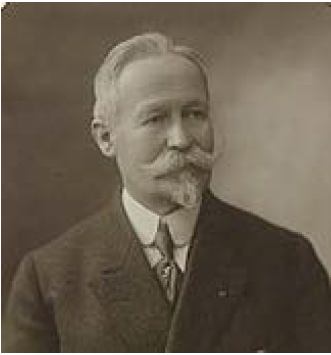
Charles Lallemand, the first President (1919–1933) Charles Lallemand (France, 1857–1938) was a geodesist, known for his scientific work to determine precise heights above mean sea level. He graduated from l'Ecole Polytechnique and Ecole des Mines in Paris. From 1884 until 1928 he was head of the French National Bureau of Surveying. Lallemand was the French delegate to the July 1919 meeting of the International Research Council in Brussels, during which he was elected IUGG President. He was elected to the French Academy of Sciences in 1910, and became the President of the Academy in 1926. Lallemand was also President of the Société astronomique de France (1923–1925). Lallemand was described as a personality of great charm and refinement, an expression of courtesy mingled with firmness, and a mind endowed with an admirable power of expressing its thoughts in clear and precise language (source: Perrier, 1938). (Courtesy: Academie des sciences)
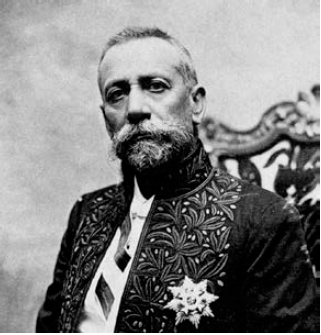
Prince Albert I, the first Vice President of IUGG (1919–1922) Prince Albert I of Monaco (1848–1922) was an oceanographer and statesman. Prince Albert I devoted much of his life to the study of the sea and oceans. Being a great promoter of oceanographic science, Prince Albert I founded the Oceanographic Institute in Monaco in 1906. Following the International Geographic Congress in 1908, the International Commission for the Scientific Exploration of the Atlantic was established alongside a similar commission for the Mediterranean, and Prince Albert I became the chairperson of both commissions. Prince Albert I always had a strong interest in international cooperation. Already in 1900, he had granted his patronage to the establishment of the short-lived International Marine Association, the last meeting of which was in 1904. In 1919, when one of the IUGG Sections was assigned to Physical Oceanography, Prince Albert I took on the role of its first President (source: Smythe-Wright et al., 2019). (Courtesy: NOAA)
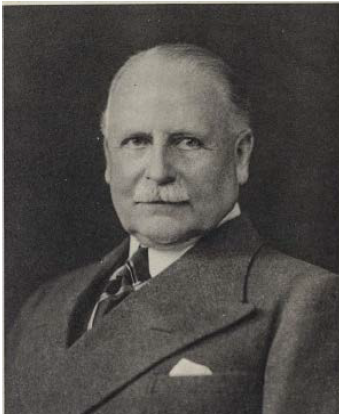
Sir Henry George Lyons, the first Secretary General (1919–1930) Colonel Sir Henry George Lyons (UK, 1864–1946), Fellow of the Royal Society, was a geologist. Lyons was educated at Wellington College and the Royal Military Academy, Woolwich, and at the age of 18 was elected to the Geological Society. In 1884 he was commissioned a Lieutenant in the Royal Engineers. In 1920, with the retiring rank of colonel, Lyons became director of the Science Museum in London. Lyons was elected Foreign Secretary of the Royal Society in 1928, Secretary General of the International Research Council in 1928, and the first ICSU Secretary General in 1931. Lyons played a crucial role in the formation of IUGG and its earlier development, wisely managing the Union (source: Dale, 1944). (Courtesy: Royal Society)

William Bowie, President (1933–1936) William Bowie (USA, 1872–1940) was an geodetic engineer known for scientific work in the theory of isostasy and its applications to dynamic and structural geology. He was educated at Trinity College in Hartford, Connecticut (B.S. 1893; M.A. 1907; Sc.D. 1919), and Lehigh University in Bethlehem, Pennsylvania (C.E. 1895; Sc.D. 1922). In 1895 Bowie joined the United States Coast and Geodetic Survey. During World War I he served in the United States Army Corps of Engineers as a major. He represented the United States at various international geodetic conferences and congresses. His scientific researches dealt with the theory of isostasy and its applications to dynamic and structural geology. Bowie was President of the International Association of Geodesy (1922–1933) before he was elected IUGG President. “It was a difficult matter to succeed the late Charles Lallemand who led the Union so brilliantly for fourteen years […] William Bowie did add to […] the significance of that post, because his geophysical interests were unusually wide and he could envisage no future in which geodesy did not work hand in glove with geophysics”, wrote Winterbotham (1940). The Bowie Seamount and the Bowie Canyon are named after William Bowie. The William Bowie Medal, the highest honor of the American Geophysical Union, is named in his honor (source: Fleming, 1951). (Courtesy: US National Academy of Sciences)
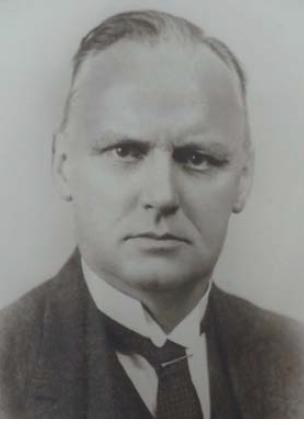
Dan la Cour, President (1936–1942) Dan Barfod la Cour (Denmark, 1876–1942) was a scientist, instrument constructor, and international coordinator in geomagnetism and meteorology. Dan la Cour received his M.Sc. degree from the University of Copenhagen in 1902, and became assistant professor at the Technical University of Copenhagen in 1908. Dan la Cour participated in the Danish Meteorological Institute's (DMI) aurora expeditions to Iceland and Finland in 1899–1901, and was permanently employed at DMI in 1900. From 1903 he held various positions in DMI, becoming the Institute's Director in 1923 and keeping this position until his death in 1942. In 1925, he established the first magnetic observatory in Godhavn, Greenland, and initiated magnetic observations from Thule, Greenland, during the Second IPY. Dan la Cour served the international scientific community as President of the Scientific Commission for the Second IPY (1929–1933) and as Secretary General of the International Association of Terrestrial Magnetism and Electricity (1933–1936) before he was elected IUGG President (source: Egedal, 1942). (Courtesy: DMI)
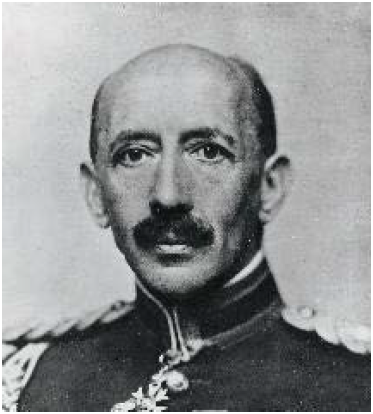
Brigadier Harold St. John Lloyd Winterbotham, Secretary General (1930–1946) Brigadier Harold St. John Lloyd Winterbotham
(UK, 1879–1946) was educated at Fettes College, Edinburgh, and the Royal
Military Academy and was commissioned in the Royal Engineers in 1897. He was
placed in charge of the Trigonometical and Topographical Division of the
Ordinance Survey at Southampton in 1911. He returned in 1920, after duty as a
military surveyor in WWI, and became Chief of the Geographical Section,
contributing to texts on field surveying and the development of the
Travistock theodolite. He was one of the original founders of the Field
Survey Association. In 1930, he was appointed Director General of the
Ordnance Survey, Great Britain's national mapping agency, retiring 1935. In
1930 he succeeded Sir Henry Lyons as IUGG Secretary General (Lyons resigned
to become the IRC Secretary General) and is credited with safeguarding IUGG
international interests and funds throughout WWII. He convened an Executive
Committee in 1945, assisted with a radical revision of the Union's Statutes
and Bylaws, and arranged for the extraordinary General Assembly in 1946 that
renewed the Union (source: Cheetham, 1947). (Courtesy: Mitchell families
online)
Each of these scientific leaders contributed to the development of what has become a vibrant, diverse network that traverses borders of discipline, country, language, and more. As the Union has grown and matured, its impact and reach have grown.
IUGG was formed and exists to promote international scientific research of Earth and its space environment for the advantage of their National Members, scientists, and society in general. During the period between the formation of IUGG in 1919 and the beginning of WWII, the Union grew in the number of its Member countries, increasing from 9 founding Member countries to 32. Seven general assemblies were held during this time of initial development, and the number of delegates attending the assemblies increased from a few dozen to more than 800 people, who participated in the IUGG General Assembly in Washington, DC in 1939.
IUGG coordinated and promoted scientific activities of its Sections (later Associations) during this initial period. Surveys to measure the Earth's surface in relation to the geometry of the theoretical figure of the Earth (the geoid) required sophisticated measurements of gravitational characteristics. New instruments for the measurements become available in the 1920–30s, and they could be easily transported to different regions of the world, allowing for comparative studies. New principles were introduced in many kinds of measurements, and IUGG, with its Section of Geodesy and other Sections, did valuable work in making the principles widely known. The Section of Scientific Hydrology promoted scientifically the areas of societal need, such as the production of energy, water security, irrigation, and flooding. The Section of Meteorology had fostered international codes for transmitting information about meteorological conditions, and proposed to review scientific methods of weather forecasting as applied in different countries. In the 1930s, IUGG promoted standardization of methods (e.g., for rainfall measurements) and of instruments used in different countries. The Section of Physical Oceanography promoted a collaboration between many bodies concerned with particular seas and oceans (e.g., the Mediterranean Sea, and the Atlantic and Pacific oceans). In the 1920–30s, seismologists benefited from the rapid transmission of information and data by telegraph and then by radio. The Section of Seismology encouraged national seismic services to set up seismic observatories in places prone to seismic and volcanic hazards. The Section of Volcanology promoted the importance of collecting and disseminating information, encouraging the collection of information on active volcanoes, the substances emitted, the temperature, and other characteristics of lava and hot springs. This Section drew attention to importance of the study of atmospheric dust due to volcanic eruptions as well as the importance of providing information on submarine eruptions that ships observed (Greenaway, 1996).
Although the WWII interrupted active scientific cooperation among nations, after the war, cooperation was restored and intensively developed (Joselyn and Ismail-Zadeh, 2019; Joselyn et al., 2019). The foundations of the Union offer insight into the motivations for its development; and subsequent articles in this Special Issue will explore how the organization has evolved in a changing global landscape.
The paper is based on published documents (see a list of references) and IUGG Archive documents. The original hard-copy documents of IUGG are deposited in the Niels Bohr Library and Archives of the American Institute of Physics (AIP, 2019). The documents are accessible only in the library with permission from the IUGG secretary general.
AIZ and JAJ contributed equally to the analysis and writing the paper, JAJ visited the AIP Niels Bohr Library and Archives to work with IUGG archive documents, and AIZ prepared the paper for publication.
The authors declare that they have no conflict of interest.
This article is part of the special issue “The International Union of Geodesy and Geophysics: from different spheres to a common globe” (https://www.hist-geo-space-sci.net/special_issue996.html). It is not associated with a conference.
The authors are grateful to Tom Beer, Harsh Gupta, Masaru Kono, and Uri Shamir for useful discussion; to Hans Volkert for providing references to
publications on IUGG history; to Peter Stauning for providing material for
Dan Barfod la Cour's biography; and to Franz Kuglitsch for preparing Figs. 1
and 2. We are thankful to Kristine C. Harper, two anonymous reviewers, and
the topical editor for constructive comments and useful suggestions for
revision.
Edited by: Hans Volkert
Reviewed by: Kristine Harper and two anonymous referees
AIP: Records of the International Union of Geodesy and Geophysics, 1922–2000 (bulk 1955–1998), Description of collection, American Institute of Physics, Center for History of Physics, available at: https://history.aip.org/ead/20010000.html (last access: 30 January 2019), 2019.
Angus-Leppan, P. V.: A note on the history of the International Association of Geodesy, J. Geodesy, 58, 224–229, 1984.
Bauer, L. A.: Geophysics at the Brussels meetings, Science, 50, 399–403, 1919.
Beer, T., Li, L., and Alverson, K. (Eds.): Global Change and Future Earth: The Geoscience Perspective, Cambridge University Press, Cambridge, 2018.
Chapman, S.: International Union of Geodesy and Geophysics, Nature, 144, 717–718, 1939.
Chapman, S.: Early international co-operation in geonomy, IUGG Newsletters 10, 271–273, 1955.
Cheetham, G.: Obituary: Brigadier H. St. J. L. Winterbotham, C. B., C. M. G., Nature, 159, 362–363, 1947.
Cock, A. G.: Chauvinism and internationalism in science: the International Research Council, 1919–1926, Notes Rec. R. Soc. Lond., 37, 249–288, 1983.
Collier, P.: Edward Sabine and the “Magnetic Crusade”, in: History of Cartography, edited by: Liebenberg, E., Lecture Notes in Geoinformation and Cartography, Springer, Berlin-Heidelberg, 309–323, 2014.
Dale, H. H.: Henry George Lyons, 1864–1944, Obituary Notices of Fellows of the Royal Society, 794–809, https://doi.org/10.1098/rsbm.1944.0023, 1944.
Davies, A. (Ed.): Forty years of progress and achievement: A historical review of WMO, WMO publ. No. 721, 1990.
Egedal, J.: Dan Barfod La Cour, 1876–1942, J. Geophys. Res., 47, 261–264, 1942.
Fleming, J. A.: Washington Assembly of the International Union of Geodesy and Geophysics and The American Geophysical Union, Science, 91, 439–442, 1940.
Fleming, J. A.: William Bowie, 1872–1940: a biographical memoir, National Academy of Sciences, Washington D.C., 61–98, 1951.
Good, G. A.: The Assembly of geophysics: scientific disciplines as frameworks of consensus, Stud. Hist. Phil. Mod. Phys., 31, 259–292, 2000.
Greenaway, F.: Science International: A history of the International Council of Scientific Unions, Cambridge University Press, Cambridge, UK, 1996.
Ismail-Zadeh, A.: Geoscience international: the role of scientific unions, Hist. Geo Space Sci., 7, 103–123, https://doi.org/10.5194/hgss-7-103-2016, 2016a.
Ismail-Zadeh, A.: Mapping IUGG to Sustainable Development Goals, IUGG Electronic Journal, 16, 1–2, 2016b.
Ismail-Zadeh, A., Urrutia Fucugauchi, J., Kijko, A., Takeuchi, K., and Zaliapin, I. (Eds.): Extreme Natural Hazards, Disaster Risks and Societal Implications, Cambridge University Press, Cambridge, 2014.
IRC: The International Research Council, Nature, 122, 389–391, 1928.
IUGG: The International Union of Geodesy and Geophysics, Nature, 132, 599–600, 1933.
IUGG: International Union of Geodesy and Geophysics – General Assembly at Edinburgh, Nature, 138, 650, 1936.
IUGG: Addresses at the opening assembly of the International Union of Geodesy and Geophysics on 6 Sep. 1939, Science, 90, 339–345, 1939.
IUGG: Report of the Union for the War Years 1939–1945, edited by: Stagg, J. M., Cambridge, UK, 158 pp., 1946.
IUGG Archive: Resolutions of the Seventh General Assembly of the IUGG, available at: http://www.iugg.org/resolutions/IUGG_Resolutions_1939.pdf (last access: 16 January 2019), Washington, D.C., 1939.
Joselyn, J. A. and Ismail-Zadeh, A.: IUGG evolves (1940–2000), Hist. Geo Space Sci., 10, this special issue, available at: https://www.hist-geo-space-sci.net/special_issue996.html, 2019.
Joselyn, J. A., Ismail-Zadeh, A., Beer, T., Gupta, H., Kono, M., Shamir, U., Sideris, M., and Whaler, K.: IUGG in the 21st century, Hist. Geo Space Sci., 10, this special issue, available at: https://www.hist-geo-space-sci.net/special_issue996.html, 2019.
Li, J. Swinbank, R., Grotjahn, R., and Volkert, H. (Eds.): Dynamics and Predictability of Large-Scale, High-Impact Weather and Climate Events, Cambridge University Press, Cambridge, 2016.
Linthe, H.-J.: Observatories in Germany, in: Encyclopedia of Geomagnetism and Paleomagnetism, edited by: Gubbins, D. and Herrero-Bervera, E., Springer, Dordrecht, the Netherlands, 729–731, 2007.
Lyons, H. G.: The Brussels meeting of the International Research Council, Nature, 103, 464–466, 1919.
Lyons, H. G.: The International Union of Geodesy and Geophysics, Nature, 109, 758–759, 1922.
Lyons, H. G.: The International Union of Geodesy and Geophysics, Nature, 114, 697, 1924.
Lyons, H. G.: The International Union of Geodesy and Geophysics, Nature, 120, 494–495, 1927.
Lyons, H. G.: The International Union of Geodesy and Geophysics, Nature, 126, 585–586, 1930.
Perrier, G.: Funérailles de Charles Lallemand, Academie des Sciences, 238–245, available at: http://www.academie-sciences.fr/pdf/eloges/lallemand_notice.pdf (last access: 20 February 2019), 1938.
Pomerantzef, I. I.: Note sur le projet de statuts pour une Association international de Sismologie, élaboré au congrès de Strassbourg, Comptes Rendus des Séances de La Commission Sismique Permanente, Académie Impériale des Sciences, vol. 1, St.-Pétersbourg, 1904. (in Russian, French, and English)
Schweitzer, J.: The early German contribution to modern seismology, in: International Handbook of Earthquake and Engineering Seismology, edited by: Lee, W., Kanamori, H., Jennings, P., and Kisslinger, C., Elsevier, Berlin, 1347–1350, 2003.
Scientific Events: International science and the war, Science, 50, 453–454, 1919.
SIPY: International Commission for the Polar Year, 1932–1933, Nature, 131, 810–811, 1933.
Smythe-Wright, D., Gould, J., McDougall, T., Sparnocchia, S., and Woodworth, P.: IAPSO: tales from the ocean frontier, Hist. Geo Space Sci., 10, this special issue, available at: https://www.hist-geo-space-sci.net/special_issue996.html, 2019.
Spencer-Jones, H.: The early history of ICSU, ICSU Review, 2, 179, 1960.
Stagg, J. M.: The International Union of Geodesy and Geophysics, Nature, 160, 558–559, 1947.
Winterbotham, H. St. J. L.: Dr. William Bowie, Nature, 146, 645, 1940.
Wood, H. O.: Organization of the American Section of the International Geophysical Union, Science, 50, 233–238, 1919.
- Abstract
- Introduction
- IUGG today
- Early development of IUGG
- IUGG General Assemblies
- Distinguished leadership
- Conclusions
- Data availability
- Appendix A: IUGG Union Commissions, Working Group, and standing Committees
- Appendix B
- Author contributions
- Competing interests
- Special issue statement
- Acknowledgements
- References
- Abstract
- Introduction
- IUGG today
- Early development of IUGG
- IUGG General Assemblies
- Distinguished leadership
- Conclusions
- Data availability
- Appendix A: IUGG Union Commissions, Working Group, and standing Committees
- Appendix B
- Author contributions
- Competing interests
- Special issue statement
- Acknowledgements
- References





